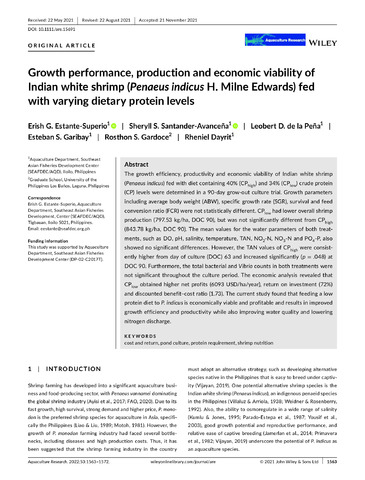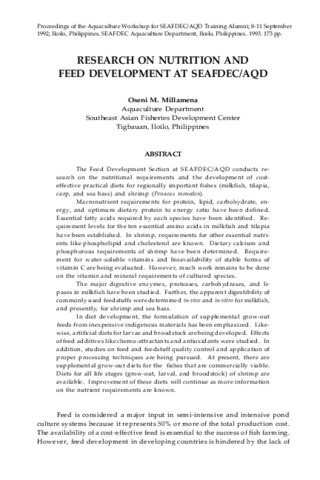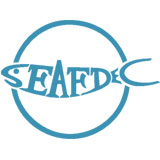Growth performance, production and economic viability of Indian white shrimp (Penaeus indicus H. Milne Edwards) fed with varying dietary protein levels

View/
Request this document
Date
2022-03Author
Page views
499Metadata
Show full item recordCited times in Scopus
Share
Abstract
The growth efficiency, productivity and economic viability of Indian white shrimp (Penaeus indicus) fed with diet containing 40% (CPhigh) and 34% (CPlow) crude protein (CP) levels were determined in a 90-day grow-out culture trial. Growth parameters including average body weight (ABW), specific growth rate (SGR), survival and feed conversion ratio (FCR) were not statistically different. CPlow had lower overall shrimp production (797.53 kg/ha, DOC 90), but was not significantly different from CPhigh (843.78 kg/ha, DOC 90). The mean values for the water parameters of both treatments, such as DO, pH, salinity, temperature, TAN, NO2-N, NO3-N and PO4-P, also showed no significant differences. However, the TAN values of CPhigh were consistently higher from day of culture (DOC) 63 and increased significantly (p = .048) at DOC 90. Furthermore, the total bacterial and Vibrio counts in both treatments were not significant throughout the culture period. The economic analysis revealed that CPlow obtained higher net profits (6093 USD/ha/year), return on investment (72%) and discounted benefit–cost ratio (1.73). The current study found that feeding a low protein diet to P. indicus is economically viable and profitable and results in improved growth efficiency and productivity while also improving water quality and lowering nitrogen discharge.
Suggested Citation
Estante-Superio, E., Santander-Avancena, S., de la Peña, L. D., Garibay, E. S., Gardoce, R. S., & Dayrit, R. (2022). Growth performance, production and economic viability of Indian white shrimp (Penaeus indicus H. Milne Edwards) fed with varying dietary protein levels. Aquaculture Research , 53(4), 1563-1572. https://doi.org/10.1111/are.15691
Subject
Collections
- AQD Journal Articles [1240]
Related items
Showing items related by title, author, creator and subject.
-
Research on nutrition and feed development at SEAFDEC/AQD
Millamena, Oseni M. (Aquaculture Department, Southeast Asian Fisheries Development Center, 1993)The Feed Development Section at SEAFDEC/AQD conducts research on the nutritional requirements and the development of costeffective practical diets for regionally important fishes (milkfish, tilapia, carp, and sea bass) and ... -
Evaluation of leguminous seed meals and leaf meals as plant protein sources in diets for juvenile Penaeus indicus
Eusebio, Perla S.; Coloso, Relicardo M. (Society of Israeli Aquaculture and Marine Biotechnology, 1998)The potential of locally available legumes (white cowpea, Vigna unguiculata, and green mung-bean, Vigna radiata) and leaf meals (papaya, Carica papaya, and cassava, Manihut esculenta) in combination with defatted soybean ... -
Evaluation of various protein sources for Penaeus monodon postlarvae
Lim, Chhorn; Suraniranat, Prawit; Platon, Rolando R. (University of the Philippines, Los Baños, 1979)Penaeus monodon postlarvae with an average weight of 15.61 mg each were fed fresh brown mussel meat and artificial diets containing casein, shrimp meal, squid meal and Spirulina as protein sources at a daily rate of 20 per ...




